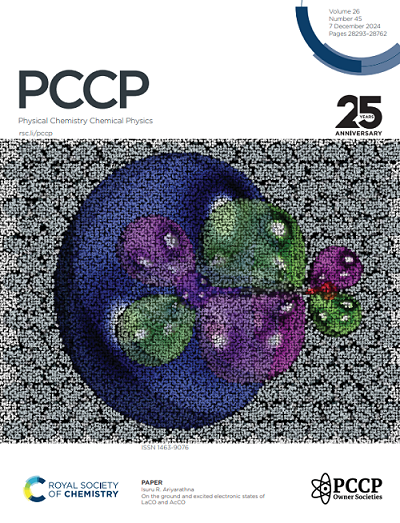TiO2(110)的水化、羟基化和掺杂对沙林吸附和分解的影响。密度泛函理论研究
IF 2.9
3区 化学
Q3 CHEMISTRY, PHYSICAL
引用次数: 0
摘要
金属氧化物是化学战剂吸附和分解的有前途的候选者,可以成为新型化学战剂破坏技术的基础。在这项工作中,我们使用密度泛函理论(DFT)来探索金属氧化物TiO2(110)的干、湿和掺杂状态如何影响神经毒剂沙林的吸附和化学解离。DFT计算表明,对于TiO2(110)的所有干态、湿态和掺杂态,沙林的解离吸附比分子吸附在能量上更有利。计算出的沙林在干燥TiO2(110)上吸附的能垒表明,沙林最初以分子构型吸附,随后发生解离过程。对于沙林在湿TiO2上的吸附,在水合和羟基化状态下,与干燥和其他湿润水平相比,0.5 H2O单层(ML)的吸附能最低。最后,与掺杂Zr和Ge的TiO2(110)以及未掺杂体系相比,掺杂Hf的TiO2(110)对沙林的吸附表现出更低的吸附能和更高的电荷转移。这些结果证明了TiO2(110)的水化、羟基化和掺杂如何显著影响沙林在这种金属氧化物上的吸附和分解。本文章由计算机程序翻译,如有差异,请以英文原文为准。
Influence of hydration, hydroxylation, and doping of TiO2(110) on the adsorption and decomposition of sarin. A density functional theory investigation
Metal oxides are promising candidates for the adsorption and decomposition of chemical warfare agents (CWA) and can be the foundations of novel CWA destruction technologies. In this work, we use density functional theory (DFT) to explore how dry, wet and doped states of the metal oxide TiO2(110), influence the adsorption and chemical dissociation of the nerve agent, sarin. The DFT calculations show that the dissociative adsorption of sarin is more energetically favored than the molecular adsorption for all dry, wet and doped states of TiO2(110). The calculated energy barrier for the adsorption of sarin on dry TiO2(110) showed that sarin is initially adsorbed with a molecular configuration, followed by the dissociative process. For the adsorption of sarin on wet TiO2, under both hydrated and hydroxylated states, the 0.5 H2O monolayer (ML) showed the lowest adsorption energy compared to the dry and other wetness levels explored. Finally, the adsorption of sarin on TiO2(110) doped with Hf showed lower adsorption energy and higher charge transfer compared with TiO2(110) doped with Zr and Ge, as well as the undoped systems. These results demonstrate how hydration, hydroxylation, and doping of TiO2(110) significantly influence the adsorption and decomposition of sarin on this metal oxide.
求助全文
通过发布文献求助,成功后即可免费获取论文全文。
去求助
来源期刊

Physical Chemistry Chemical Physics
化学-物理:原子、分子和化学物理
CiteScore
5.50
自引率
9.10%
发文量
2675
审稿时长
2.0 months
期刊介绍:
Physical Chemistry Chemical Physics (PCCP) is an international journal co-owned by 19 physical chemistry and physics societies from around the world. This journal publishes original, cutting-edge research in physical chemistry, chemical physics and biophysical chemistry. To be suitable for publication in PCCP, articles must include significant innovation and/or insight into physical chemistry; this is the most important criterion that reviewers and Editors will judge against when evaluating submissions.
The journal has a broad scope and welcomes contributions spanning experiment, theory, computation and data science. Topical coverage includes spectroscopy, dynamics, kinetics, statistical mechanics, thermodynamics, electrochemistry, catalysis, surface science, quantum mechanics, quantum computing and machine learning. Interdisciplinary research areas such as polymers and soft matter, materials, nanoscience, energy, surfaces/interfaces, and biophysical chemistry are welcomed if they demonstrate significant innovation and/or insight into physical chemistry. Joined experimental/theoretical studies are particularly appreciated when complementary and based on up-to-date approaches.
 求助内容:
求助内容: 应助结果提醒方式:
应助结果提醒方式:


